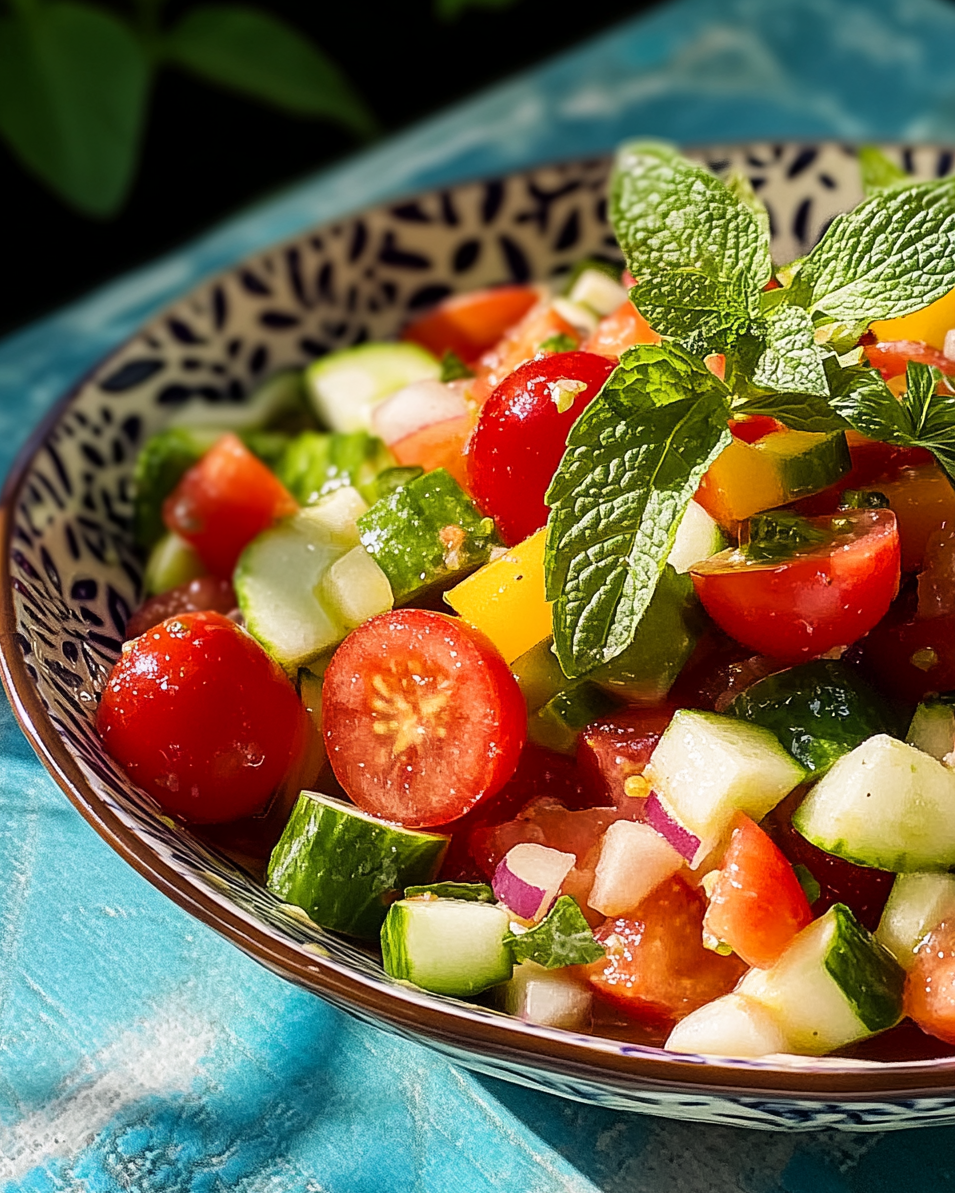The Shiraz Salad, with its fresh and vibrant ingredients, is a Persian classic that combines juicy tomatoes, crisp cucumbers, and fragrant herbs such as parsley and mint. The salad is dressed simply with olive oil, lemon juice, salt, and pepper, creating a refreshing, healthy dish that complements a variety of meals.
This easy-to-make salad is perfect for summer gatherings, as a side dish, or even as a light, standalone meal. The ingredients are simple but packed with fresh flavors, making it an excellent option for those seeking a nutritious and delicious salad with minimal prep time.
Full Recipe:
- 4 medium tomatoes, diced
- 1 English cucumber, diced
- 1/2 red onion, finely chopped
- 1/4 cup fresh parsley, chopped
- 1/4 cup fresh mint, chopped
- 2 tablespoons olive oil
- 1 tablespoon lemon juice
- Salt and pepper to taste
Directions:
- In a large bowl, combine the diced tomatoes, cucumber, and red onion.
- Add the chopped parsley and mint, then drizzle with olive oil and lemon juice.
- Season with salt and pepper to taste, and gently toss to combine.
- Serve chilled or at room temperature.
Prep Time: 15 minutes | Cooking Time: 0 minutes | Total Time: 15 minutes
Kcal: 80 kcal | Servings: 4 servings
The Shiraz Salad, also known as Salad-e Shirazi, is a traditional Persian salad that originates from the city of Shiraz in southern Iran. This refreshing and healthy dish is made with simple ingredients such as tomatoes, cucumbers, red onions, and fresh herbs like parsley and mint. It’s a staple in Persian cuisine and is often served as a side dish to accompany grilled meats, stews, or rice dishes.
Why Shiraz Salad Stands Out:
- Refreshing and Light: Shiraz Salad is incredibly light and refreshing, making it the perfect dish for hot summer days. The combination of fresh cucumbers and juicy tomatoes, dressed in olive oil and lemon juice, provides a burst of flavor and hydration.
- Nutrient-Rich Ingredients: This salad is packed with essential vitamins and minerals. Tomatoes and cucumbers are both rich in antioxidants, vitamins A and C, and hydration-boosting water content. The addition of herbs like mint and parsley not only adds flavor but also brings in a dose of fiber, iron, and vitamins K and A.
- Versatility: While it is traditionally served alongside Persian kabobs or rice dishes like Baghali Polo (Rice with Fava Beans), Shiraz Salad can also be a refreshing side for a variety of meals, including grilled fish, chicken, or even Mediterranean dishes. It can also be enjoyed as a light and healthy snack on its own.
- Simple and Quick to Prepare: One of the best features of Shiraz Salad is how quick and easy it is to make. With no cooking involved, it can be prepared in just 15 minutes. It’s a great go-to recipe for busy weeknights or when you want something fresh without spending too much time in the kitchen.
- Perfect for Special Diets: This salad is naturally gluten-free, vegan, and vegetarian, making it a great option for those following special diets. You can even modify the ingredients slightly by adding more vegetables like radishes or carrots to suit your personal taste.
Tips for the Best Shiraz Salad:
- Freshness is Key: Always use the freshest vegetables and herbs you can find. The crispness of the cucumbers and the juiciness of ripe tomatoes make all the difference in the flavor of the salad.
- Serve Immediately: Shiraz Salad is best enjoyed fresh. While it can be stored in the fridge for up to a day, it’s recommended to serve it soon after making for the best texture and taste.
- Personalize It: Feel free to personalize this salad by adding ingredients like pomegranate seeds for a touch of sweetness or sumac for a bit of tangy flavor.
Cultural Significance of Shiraz Salad
Shiraz Salad is not just a refreshing side dish; it holds a special place in Persian culinary traditions. In Iran, meals are often communal events where the balance of flavors and textures is crucial. The salad is often served alongside rich and hearty dishes like Kebabs, Ghormeh Sabzi (Persian herb stew), or Fesenjan (walnut and pomegranate stew) to provide a refreshing contrast. The tanginess from the lemon juice and the crispness of the vegetables help cleanse the palate between bites of heavier dishes, enhancing the overall dining experience.
The Ingredients and Their Importance
- Tomatoes: Persian cuisine places high value on fresh, in-season produce, and tomatoes are a staple. In Shiraz Salad, ripe, juicy tomatoes form the base, adding a sweet and tangy flavor. They are also loaded with lycopene, an antioxidant that’s known to support heart health.
- Cucumbers: Known for their cooling properties, cucumbers bring a refreshing crunch to the salad. In Persian culture, cucumbers are a symbol of hospitality and are often served as part of a mezze spread to welcome guests.
- Red Onion: Finely chopped red onion gives a sharp, slightly spicy bite, adding depth to the salad’s flavor. In traditional Persian recipes, onions are often used to balance the sweetness of ingredients like tomatoes.
- Herbs (Parsley and Mint): Fresh herbs play an essential role in Persian cooking, and no Persian table is complete without a handful of fresh greens. Mint adds a cool, refreshing note, while parsley brings earthiness and depth. Together, they elevate the freshness of the salad while offering numerous health benefits, such as aiding digestion and promoting good heart health.
- Olive Oil & Lemon Juice: A simple dressing made of olive oil and lemon juice keeps the salad light and fresh. The acidity of the lemon juice brightens the flavors, while the olive oil adds a smooth, slightly fruity richness.
Health Benefits of Shiraz Salad
In addition to being delicious, Shiraz Salad is packed with nutrients and offers multiple health benefits:
- Low in Calories: At just 80 calories per serving, this salad is perfect for those looking to maintain or reduce weight while still enjoying a flavorful dish.
- Rich in Antioxidants: The tomatoes and onions are both rich in antioxidants like quercetin and lycopene, which can help reduce inflammation and protect against chronic diseases like cancer and heart disease.
- Hydrating: The cucumbers and tomatoes have a high water content, making Shiraz Salad an excellent dish for hydration, especially during the warmer months.
- Supports Digestive Health: The fresh herbs, particularly mint and parsley, are known for their digestive properties. Mint can help reduce bloating, while parsley acts as a natural diuretic, promoting a healthy digestive system.
- Heart-Healthy: Olive oil is a key component of the Mediterranean diet, which has been shown to improve heart health. Rich in healthy fats, it helps reduce bad cholesterol levels, supporting overall cardiovascular health.
Variations of Shiraz Salad
While the traditional recipe remains simple, there are several ways to adapt and personalize the Shiraz Salad based on your preferences or what’s available:
- Add Pomegranate Seeds: For a pop of color and a burst of sweetness, some variations include pomegranate seeds, which complement the tangy lemon juice perfectly.
- Sumac: If you want to add a bit more tanginess, sprinkle some sumac, a popular spice in Persian cuisine, over the salad. It has a citrus-like flavor that enhances the freshness of the dish.
- Radishes: Add thinly sliced radishes for an extra layer of crunch and a peppery kick that balances the sweetness of the tomatoes and cucumbers.
- Feta Cheese: While not traditional, adding a bit of crumbled feta cheese can give the salad a creamy, salty contrast, making it more filling as a standalone dish.
- Roasted Vegetables: For a heartier version, you can toss in roasted bell peppers or grilled zucchini. These additions introduce a smoky flavor that pairs beautifully with the fresh herbs.
Serving Suggestions
- As a Side Dish: Shiraz Salad is traditionally served alongside grilled meats like Kabab Koobideh or Joojeh Kabab (grilled chicken skewers), and rice dishes such as Chelo (Persian plain rice). The refreshing salad cuts through the richness of the meats, providing a balanced meal.
- As a Light Meal: Thanks to its simple yet satisfying nature, Shiraz Salad can be enjoyed as a light lunch on its own. Pair it with some flatbread, hummus, or grilled pita for added texture and fullness.
- At a Mezze Table: Incorporate Shiraz Salad into a mezze platter with other Middle Eastern favorites like hummus, baba ganoush, olives, and fresh bread. It’s a great way to present a variety of flavors in a social setting.
A Dish Rooted in Tradition
Shiraz Salad is an integral part of Persian cuisine, and its simplicity speaks to the elegance of traditional Iranian cooking. It’s a dish that has been passed down through generations, a reminder of the importance of fresh, quality ingredients and the beauty of natural flavors.
Conclusion
Shiraz Salad is a refreshing, nutrient-packed, and easy-to-make dish that highlights the simplicity and elegance of Persian cuisine. With its fresh vegetables, herbs, and light lemon-olive oil dressing, it’s perfect as a side or a standalone meal. The salad’s versatility, low calorie count, and numerous health benefits make it a must-try for anyone looking to add a flavorful and healthy option to their meal rotation. Whether served at a summer gathering or a casual dinner, Shiraz Salad is sure to impress.






